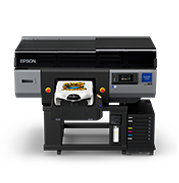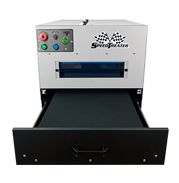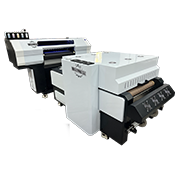New consumer demands are paving the way for technology that falls in the middle of the capabilities of screen and DTG printing.
In the ever-changing world of garment and product decoration, a new category has emerged — somewhere between the one-off decorator and volume screen printers.
On one side is the instant satisfaction of direct-to-garment (DTG) printing, cut vinyl, transfers and sublimation. These solutions fit in a world where companies like Amazon quickly
deliver what end users order, sometimes in the same day. It fits the modern consumer’s new mantra: “I want one; I want it custom; and I want it now.”
On the other side is traditional screen printing. Whether short or long runs, the preparation and setup processes are the same. Preparing film positives; prepping and coating screens; exposing; washing out; taping; and aligning screens on the press occurs each time, whether it’s for one or 5,000 shirts. Obviously, the longer the run, the more efficient a screen printer can be.
The Hybrid Consumer and Decorator
Today’s consumer has an eye on DTG printing’s instant gratification, but still sometimes needs the higher quantities afforded by screen printing. The decorator needs a way to fill the void that exists somewhere between one and 1,000 shirts.
Most DTG decorating instantly produces a completely custom, full-color product on any garment color. Time wise and financially, however, instant printing does not translate well in quantities greater than a few dozen. Prior to these new hybrids, DTG production times averaged two minutes per shirt. Screen printers can produce hundreds per hour. And ink costs were higher, averaging $2 per garment, while screen-printing ink is just pennies per print.
Screen printing is most efficient when it comes to quantity. A decorator can produce just a dozen shirts profitably if the graphic is only one or two colors. But as colors get added, the number of prints required to ensure efficiency multiplies. A full-color (six-screen) image for most decorators only becomes profitable at 100 or more pieces. Most screen printers make a living at one- to three-color images, with full-color printing being outside their expertise.
Many customers who, in the past, would buy 10,000 pieces now ask for only a few hundred pieces, with future orders repeating in the same quantity. These customers are looking through fresh eyes, saying they no longer want to risk capital on large quantities of inventory, but prefer to replenish stock as needed.
New DTG Capabilities Close the Gap
New developments in DTG machines in the past year or so have helped fill this gap. These new printers offer lower costs, sometimes half the ink cost of traditional DTG printing. Plus, they offer faster production speeds, often double what DTG machines were capable of only a couple of years ago. These factors make the break-even point lower when choosing to embellish garments via DTG or screen printing.
Higher DTG-printing speeds have been available for quite some time, but at a high cost of entry. New DTG machines that are available on the market today are a fraction of the cost of these earlier machines. Decorators also have attempted to match screen-printing efficiency by operating multiple DTG printers, even simultaneously.
Comparing Finished Products
Many consumers probably would be surprised to know how many DTG-printed products they own that they assume have been screen printed. If the product was bought online, chances are good that it’s a DTG print. For online resellers, the ability to maintain blank inventory while printing on demand has been the force driving DTG production.
With screen or DTG printing, you can produce an excellent finished print. With proper preparation and proper curing, you will produce a permanent print. In our industry, 50 or more washes without image degradation is considered a permanent print.
Some screen printers like to use DTG technology to fill in inventory gaps. To accomplish this, the art department must simulate a screen-printed image by using halftone dots (55 lines, for instance) rather than full CMYK process printing. Screen printing a full-color image often is accomplished through simulated-process printing using a minimum of six screens. A DTG print may have 100 colors or shades of colors in an image.
Most DTG decorators still use heat presses to cure their finished prints. But in the new hybrid world, using a conveyor dryer — like screen printers — is almost required to be most efficient. Attempting to maintain the production capability of these new DTG printers with multiple heat presses would create a costly time bottleneck.
Surely, the hybrid operator will soon be taking a seat at the garment decorators’ table — and that seat will be located somewhere between one-off DTG printing and longer-run screen printing.
Terry Combs has more than 40 years of experience in the garment-printing industry, and has managed production shops large and small across the United States. He has written hundreds of articles for industry publications and spoken at industry events worldwide. He currently does DTG sales and training with Equipment Zone. For more information or to comment on this article, visit terrycombs.com.














